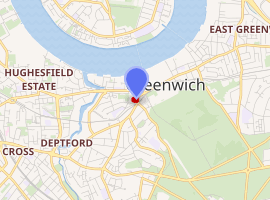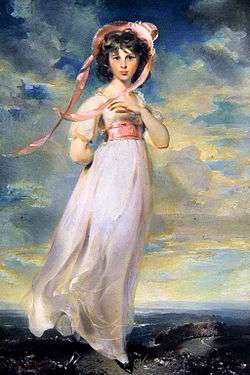St Alfege Church, Greenwich
St Alfege Church is an Anglican church in the centre of Greenwich, part of the Royal Borough of Greenwich in London. It is of medieval origin and was rebuilt in 1712–1714 to the designs of Nicholas Hawksmoor.
| St Alfege Church | |
|---|---|
 | |

| |
| Location | London, SE10 |
| Country | United Kingdom |
| Denomination | Church of England |
| History | |
| Dedicated | 1718 |
| Architecture | |
| Heritage designation | Grade I |
| Years built | 1714 (present) |
| Administration | |
| Diocese | Southwark |
| Clergy | |
| Vicar(s) | Rev Chris Moody |
| Laity | |
| Director of music | Stephen Dagg |
Early history
The church is dedicated to Alfege (also spelt "Alphege"), Archbishop of Canterbury, and reputedly marks the place where he was martyred on 19 April 1012, having been taken prisoner during the sack of Canterbury by Danish raiders the previous year. The Danes took him to their camp at Greenwich and killed him when the large ransom they demanded was not forthcoming.[1]
The church was rebuilt in around 1290, and Henry VIII was baptised there in 1491.
The patronage of the church was given to the abbey at Ghent during the 13th century. Following the suppression of alien priories under Henry V, it was granted to the priory at Sheen with which it remained until transferred to the Crown by exchange under Henry VIII in 1530.[1]
During a storm in 1710 the medieval church collapsed, its foundations having been weakened by burials both inside and outside.
The present church

Following the collapse of the medieval church, the present building was constructed, funded by a grant from the Commission for Building Fifty New Churches, to the designs of Nicholas Hawksmoor, one of the commission's two surveyors. The first church to be built by the commissioners, it was begun in 1712 and basic construction was completed in 1714;[2] it was not, however, consecrated until 1718.[3]
The church is rectangular in plan with a flat ceiling and a small apse serving as a chancel. The east front, towards the street, has a portico in the Tuscan order, with a central arch cutting through the entablature and pediment—a motif used in Wren's "Great Model" for St Paul's Cathedral.[3] A giant order of pilasters runs around the rest of the church, a feature Kerry Downes suggests may have been added by Thomas Archer, who, according to the minutes of the commission, "improved" Hawksmoor's plans.[2] On the north and south sides of the churchwide projecting vestibules rise to the full height of the building, with steps leading up to the doors.[3]
Hawksmoor planned a west tower, in the position of the existing one, which had survived the collapse. However the commission was reluctant to fund it, and the medieval tower was retained. In 1730 John James refaced it, and added a spire. Hawksmoor's design, published in an engraving in 1714, had an octagonal lantern at the top, a motif he was later to use at St George in the East.[2]
An organ, built by George England, was installed in the mid-18th century.
The crypt served as an air-raid shelter during World War II. During the Blitz on 19 March 1941, incendiary bombs landed on the roof causing it to collapse, burning into the nave. The walls and the tower remained standing but much of the interior was gutted. The church was restored by Sir Albert Richardson in 1953.
In 2015 a fund-raising cream tea garden party for Christian Aid, held in the churchyard after the Sunday sermon, was stormed by armed police. An attendee said that the vicar's wife was “almost knocked over by a policeman with a huge machine gun”, but “people just carried on drinking their tea” in a display of typical British fortitude even though “all these armed police bursting in was like the film Hot Fuzz”. The police proceeded to the adjacent Saint Alfege Park, where a man was arrested and a firearm found.[4]
The Church is currently used to celebrate "Founder's Day" of Addey and Stanhope School and The John Roan School.
Notables buried here

Notable people buried in and around the church include the Renaissance choirmaster and composer William Newark (died 1509, no surviving memorial), the composer Thomas Tallis (died 1585), the merchant Sir John Lethieullier (died 1719) on the outer south-west corner of the church, the English-born explorer of Canada Henry Kelsey (died 1724), General James Wolfe, the victor over the French in Canada but who died in the process at the Battle of the Plains of Abraham in 1759, the actress Lavinia Fenton (died 1760), and the MP Sir James Creed (died 1762) against the outer north wall.[5]
Sarah Barrett Moulton, the Jamaican-born schoolgirl (died 1795) who was the subject of the celebrated portrait Pinkie (shown at right). The merchant, Lloyd's underwriter and art collector John Julius Angerstein (died 1823), who was a churchwarden in the early 19th century, is also buried here.
Literary connection
In Charles Dickens's novel Our Mutual Friend, Bella Wilfer marries John Rokesmith in St Alfege Church.
In Tom McCarthy's novel C, after a Marinettiesque car crash, Serge Carrefax laughs from his position within the upturned chassis. This laughter is "a pleasant noise; reminds him of liturgical chants and whispers echoing around St. Alfege's interior."
See also
- List of churches and cathedrals of London
References
- Daniell, A. E. (1897). London Riverside Churches. London: Constable. pp. 288–98. Accessed 5 July 2017
- Downes, Kerry (1987) [first published 1970]. Hawksmoor. World of Art. London: Thames and Hudson. pp. 110–11.
- Cherry, Bridget; Pevsner, Nikolaus (1990) [1983]. London 2: South. The Buildings of England. London: Penguin Books.
- Morgan, Ben (18 May 2015). "Armed officers storm garden party at London church in hunt for gunman". London Evening Standard. p. 25.
- 'Greenwich: The parish church', Old and New London: Volume 6 (1878), pp. 190–205 Accessed 26 May 2007.
External links
| Wikimedia Commons has media related to St Alfege Church, Greenwich. |